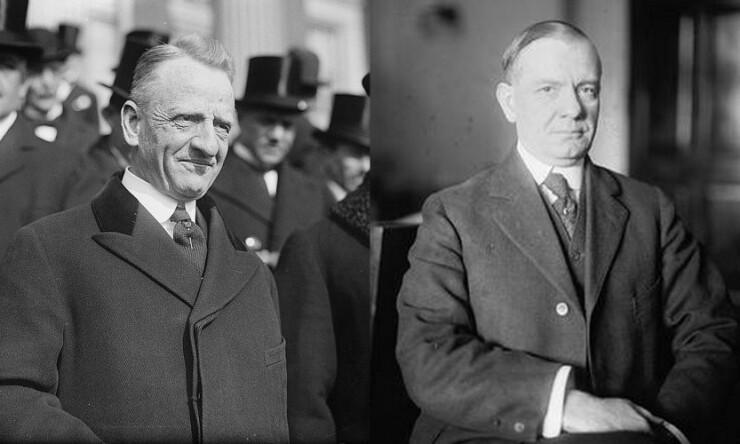Art Wilmarth’s new book, which makes a scholarly case for breaking up the nation’s largest banks, is almost 40 years in the making.
Wilmarth was a young banking lawyer in the early 1980s when he first became interested in the Glass-Steagall Act, the Depression-era law that barred U.S. banks from engaging in securities activities. At the time, financial industry lobbyists were pushing to repeal key provisions, an effort that finally came to fruition with the enactment of the Gramm-Leach-Bliley Act in 1999.
“I went back and began to look at the history,” Wilmarth, a professor emeritus at George Washington University’s law school, recalled in a recent interview. “I began to ask, ‘Why are the banks trying to tear this down? This act seems to me to make perfect sense.’ ”
Wilmarth’s deeply researched book, “Taming the Megabanks: Why We Need a New Glass-Steagall Act,” is a testament to his dedication to a topic that has only periodically drawn close attention in Washington.

The book includes an extensive historical account that spans the financial market excesses that preceded the Great Depression, Glass-Steagall’s passage, the long campaign to undo its restrictions and what has happened in the two decades since the 1933 law was largely repealed. It also features a detailed proposal for a 21st-century version of Glass-Steagall.
Wilmarth argues that restoring Glass-Steagall would reduce the threat of contagion during a future financial crisis, and would also reduce the political power of the biggest U.S. banks, which he sees as a worthy goal.
“Taming the Megabanks” was published late last year, amid a pandemic in which the U.S. banking sector has shown resilience, and during a presidential campaign in which the restoration of Glass-Steagall was not a prominent issue. Still, the debate over breaking up the big banks seems likely to regain prominence whenever the next financial crisis hits.
President Biden
During his 2016 presidential campaign, Donald Trump also expressed support for an updated version of Glass-Steagall, though he never seriously pursued the idea while in office.

The last big legislative effort to curtail risk at the large banks was the Dodd-Frank Act of 2010, which largely relied on the discretion of regulators to implement hundreds of technical reforms. Some rules required by the law, such as guardrails on incentive-based compensation at banks, have never been finalized.
Wilmarth argues that Dodd-Frank’s complexity undermines its effectiveness, since key provisions can be watered down, as happened during the Trump administration.
“It did some good things, but it was never completely robust,” he said. “You've seen how quickly it was dialed back with unsympathetic regulators.”
Of course, the history chronicled in Wilmarth’s book shows how financial industry lobbyists were also successful in gradually weakening the separation between commercial banks and securities firms that was established by Glass-Steagall. A Congressional Research Service report in 2016
Still, Wilmarth argues that a bright-line approach would be more effective than the alternative. His proposal would likely force the spinoff of the capital markets arms of JPMorgan Chase, Bank of America, Citigroup and Wells Fargo, as well as the banking arms of Goldman Sachs and Morgan Stanley.
He also wants new rules to prevent nonbanks from funding their activities through the issuance of short-term financial claims, such as money market mutual funds and commercial paper, that resemble bank deposits.
“Requiring all deposit substitutes to be issued by chartered banks would dramatically shrink the shadow banking system by forcing short-term financial claims to move from nonbanks to the regulated banking system,” Wilmarth writes.
Wilmarth offers several arguments for why Glass-Steagall should be reinstated. One rationale is that it would reduce systemic risk. Another is that the new barriers would remove conflicts of interest that he says make it impossible for universal banks to act as objective lenders or impartial investment advisers. A third reason is that it would produce greater competition in the financial system.
“A new Glass-Steagall Act would be likely to encourage substantial inflows of deposits and capital into community banks,” he writes.
Of course, the opponents of Glass-Stegall’s restoration have their own arguments. They contend that the new rules
Wilmarth has rejoinders, but a big part of his argument involves reducing the big banks’ political clout. He believes that breaking up the industry into three distinct sectors — banking, securities and insurance — would rekindle political rivalries that existed until the late 1990s but have since diminished.
“Each sector would serve as a strong counterweight against the political and regulatory influence of the others,” he writes.
His book contains a striking chart, derived from research by the economists Thomas Philippon and Ariell Reshef, that shows a strong correlation between financial sector deregulation and wages in the financial industry. Wilmarth argues that bank compensation plans in recent years have essentially privatized profits and socialized losses.
“During the first era of universal banking — in the 1920s up to 1933 — financial-sector wages were very high compared to other industry wages,” Wilmarth said. “And then, after Glass-Steagall was instituted, and regulation became much stricter, you see financial-sector wages falling precipitously.”
“Then, as soon as you get into deregulation, and particularly the undermining and repeal of Glass-Steagall, you see the financial-sector wages skyrocket again.”
Wilmarth has seemingly encyclopedic knowledge about the history of U.S. bank regulation, with the ability to recall small details about scandals that have mostly been forgotten.
“I'm biased against the big banks — I don't trust them. And so I'm inclined not to think the best of them,” he said. Then he added with a laugh: “But when you actually see this stuff from the inside revealed, you think, ‘I'm actually underestimating.’ ”





